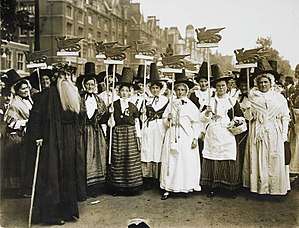Women's Coronation Procession
| Women's Coronation Procession | |||
|---|---|---|---|
| Part of first-wave feminism | |||
 Welsh suffragists in traditional dress | |||
| Date | 17 June 1911 | ||
| Location |
Westminster, London, England. Marchers converged on the Albert Hall, South Kensington. 51°30′03.40″N 00°10′38.77″W / 51.5009444°N 0.1774361°W | ||
| Caused by | Fight for women's suffrage | ||
| Methods | Demonstrations, marches[1] | ||
| Parties to the civil conflict | |||
|
| |||
| Lead figures | |||
| |||
The Women's Coronation Procession was a suffragette march through London on 17 June 1911, just before King George V's coronation, demanding women's suffrage in the coronation year. The march was organised by the Women's Social and Political Union (WSPU).
Some 40,000 people marched from Westminster to the Albert Hall in South Kensington.[2] Charlotte Despard and Flora Drummond on horseback led the march, which included Annan Bryce dressed as Joan of Arc and 700 women and girls clothed in white to represent suffragette prisoners.
Kate Harvey, Edith Downing and Marion Wallace-Dunlop were among the organisers, and Lolita Roy is believed to have been as well.[1][3] Jane Cobden organised the Indian women's delegation.[4]
Elsie Hooper and other members of the National Association of Women Pharmacists joined the march.
See also
References
- 1 2 3 4 Library, British. "Women's suffrage timeline - The British Library". Bl.uk. Retrieved 2018-02-26.
- ↑ "Celebrating Elsie Hooper, early pioneer for women pharmacists, on International Women's Day". Pharmaceutical Journal. 8 March 2018. Retrieved 10 May 2018.
- ↑ "Photograph of Indian suffragettes on the Women's Coronation Procession, 17 June 1911 at Museum of London". Museumoflondonprints.com. 1911-06-17. Retrieved 2018-02-26.
- ↑ "Indian suffragettes in the Women's Coronation Procession". Museum of London. Retrieved 22 March 2013.